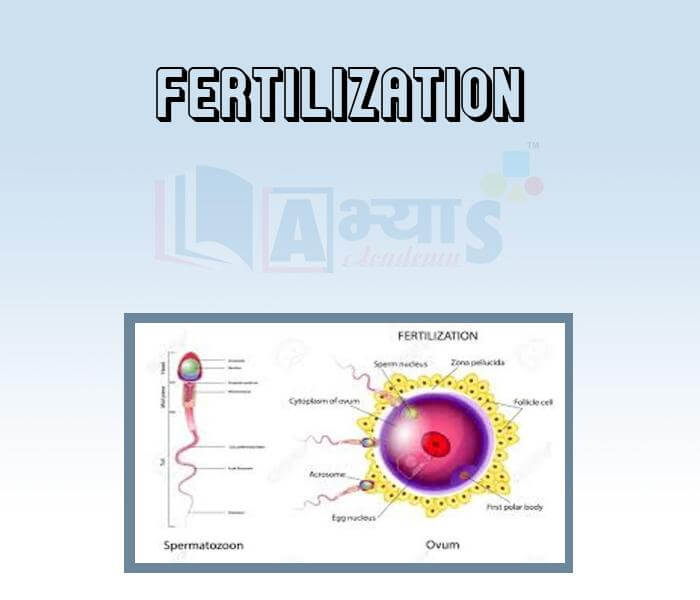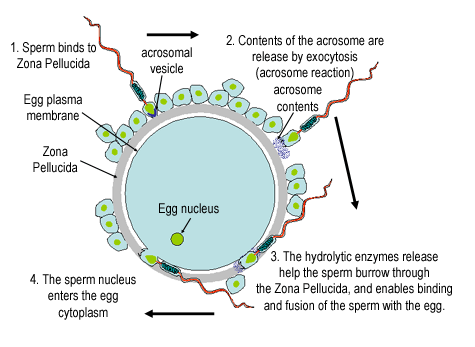Fertilization


Fertilization
Fertilization: Fertilization is a process which involves fusion of haploid gametes to give rise to a zygote. Fertilization can be of two types , External fertilization which occurs outside the body and internal fertilization which occurs with in the body.
Fertilization in plants :
In plants sexes may or may not be seperated. Accordingly, a flower is either unisexual(bearing either male or female gamete or ova) or bisexual (bearing both gametes). The pollen grain represent the male gametophyte and embryo sac represents the female gametophyte which encloses the egg. The transfer of pollen grain from anther to the stigma of other flower is called as cross pollination and if the pollen get transfered to the stigma of same flower it is called as self pollination.
After reaching the stigma pollen grains germinate on the stigma. The inner wall of the pollen grain grows into a pollen tube, which grows down through the style and finally reaches the ovule. Inside the ovule, a male gamete fuses with the female gamete and a zygote is formed. This is known as fertilization.
he zygote divides repeatedly to form the embryo (future plant) in the ovule. The embryo possesses a tiny future root (radicle), a tiny future shoot (plumule) and cotyledons to store food. The ovary grows rapidly to form the fruit. The ovary wall ripens and forms the fruit wall. The sepals, petals, stamens, style and stigma of the flower degenerate and usually fall off. Sometimes the sepals may persist in the fruit. The ovule develops into a seed. The wall of the ovule thickens to form the protective seed coat. The seed loses water and becomes hard and dry. Seeds can withstand drought and other adverse conditions in this state. This is an advantage for seed-producing plants. The embryo lies dormant in the seed, but under favourable environmental conditions it becomes active and germinates to form a small seedling. The radicle forms the root while the plumule forms the shoot. The growing root and shoot utilize the food stored in the cotyledons.

Fertilization in Humans :
The fertilization is internal in humans . The transfer of the male gamete occur by insertion of penis in to the vagina of the female. The sperms are deposited in the vagina of the female during a process called as copulation or sexual intercourse. The release of sperms is called as ejaculation. Of large number of sperms only few make the journey from the vaginal canal to the oviduct. This may ake 4 -8 hours. In the fallopian tube many sperms surrounds the egg but only one is able to fuse with it. The enzymes of acrosome digest different layers of tissue to reach the egg. Once the sperm is inside the female and male nucleus become lighter and are called as pro - nuclei. The two pro nuclei fuse to form zygote. Once a sperm enters an egg, the thickening of the outer walls of the egg blocks the entry of other sperms.

If fertilization does not take place corpus luteum will __________________ . | |||
| Right Option : C | |||
| View Explanation | |||
Assertion : Holoblastic cleavage with almost equal sized blastomeres is a characteristic of placental animals. Reason : Eggs of most mammals, including humans, are of centrolecithal type. | |||
| Right Option : C | |||
| View Explanation |
Acrosome is made up of _______________ | |||
| Right Option : C | |||
| View Explanation | |||
Students / Parents Reviews [20]
My experience with Abhyas Academy has been very good. When I was not in Abhyas whenever teacher ask questions I could not speak it confidently but when I came in Abhyas, my speaking skills developed and now I am the first one to give the answer of teachers question.

Upmanyu Sharma
7thWhen I have not joined Abhyas Academy, my skills of solving maths problems were not clear. But, after joining it, my skills have been developed and my concepts of science and SST are very well. I also came to know about other subjects such as vedic maths and reasoning.

Sharandeep Singh
7thAbhyas Methodology is very good. It is based on according to student and each child manages accordingly to its properly. Methodology has improved the abilities of students to shine them in future.

Manish Kumar
10thWe started with lot of hope that Abhyas will help in better understnding of complex topics of highers classes. we are not disappointed with the progress our child has made after attending Abhyas. Though need to mention that we expected a lot more. On a scale of 1-10, we would give may be 7.

Manya
8thAbhyas institute is one of the best coaching institute in the vicinity of Ambala Cantt area. The teachers of the institute are well experienced and very helpful in solving the problems of the students.The good thing of the institute is that it is providing extra classes for the students who are w...

Aman Kumar Shrivastava
10thAbhyas institute is one of the best coaching institute in the vicinity of Ambala cantt.The institute provides good and quality education to the students.The teachers are well experienced and are very helpful in solving the problems. The major advantages of the institute is extra classes for weak...

Shreya Shrivastava
8thMy experience with Abhyas is very good. I have learnt many things here like vedic maths and reasoning also. Teachers here first take our doubts and then there are assignments to verify our weak points.

Shivam Rana
7thI have spent a wonderful time in Abhyas academy. It has made my reasoning more apt, English more stronger and Maths an interesting subject for me. It has given me a habbit of self studying

Yatharthi Sharma
10thOne of the best institutes to develope a child interest in studies.Provides SST and English knowledge also unlike other institutes. Teachers are co operative and friendly online tests andPPT develope practical knowledge also.

Aman Kumar Shrivastava
10thAbhyas is a complete education Institute. Here extreme care is taken by teacher with the help of regular exam. Extra classes also conducted by the institute, if the student is weak.

Om Umang
10thUsually we see institutes offering objective based learning which usually causes a lag behind in subjective examinations which is the pattern followed by schools. I think it is really a work of planning to make us students grab the advantages of modes of examination, Objective Subjective and Onli...

Anika Saxena
8thAbhyas is good institution and a innovative institute also. It is a good platform of beginners.Due to Abhyas,he has got knoweledge about reasoning and confidence.My son has improved his vocabulary because of Abhyas.Teacher have very friendly atmosphere also.

Manish Kumar
10thIn terms of methodology I want to say that institute provides expert guidence and results oriented monitering supplements by requsite study material along with regular tests which help the students to improve their education skills.The techniques of providing education helps the students to asses...

Aman Kumar Shrivastava
10thThe experience was nice. I studied here for three years and saw a tremendous change in myself. I started liking subjects like English and SST which earlier I ran from. Extra knowledge gave me confidence to overcome competitive exams. One of the best institutes for secondary education.

Aman Kumar Shrivastava
10thThird consective year,my ward is in Abhyas with nice experience of admin and transport support.Educational standard of the institute recumbent at satisfactory level. One thing would live to bring in notice that last year study books was distributed after half of the session was over,though study ...

Ayan Ghosh
8thBeing a parent, I saw my daughter improvement in her studies by seeing a good result in all day to day compititive exam TMO, NSO, IEO etc and as well as studies. I have got a fruitful result from my daughter.

Prisha Gupta
8thAbhyas academy is great place to learn. I have learnt a lot here they have finished my fear of not answering.It has created a habit of self studying in me.The teachers here are very supportive and helpful. Earlier my maths and science was good but now it has been much better than before.

Barkha Arora
10thAbout Abhyas metholodology the teachers are very nice and hardworking toward students.The Centre Head Mrs Anu Sethi is also a brilliant teacher.Abhyas has taught me how to overcome problems and has always taken my doubts and suppoeted me.

Shreya Shrivastava
8thIt has a great methodology. Students here can get analysis to their test quickly.We can learn easily through PPTs and the testing methods are good. We know that where we have to practice

Barkha Arora
10thMy experience was very good with Abhyas academy. I am studying here from 6th class and I am satisfied by its results in my life. I improved a lot here ahead of school syllabus.
